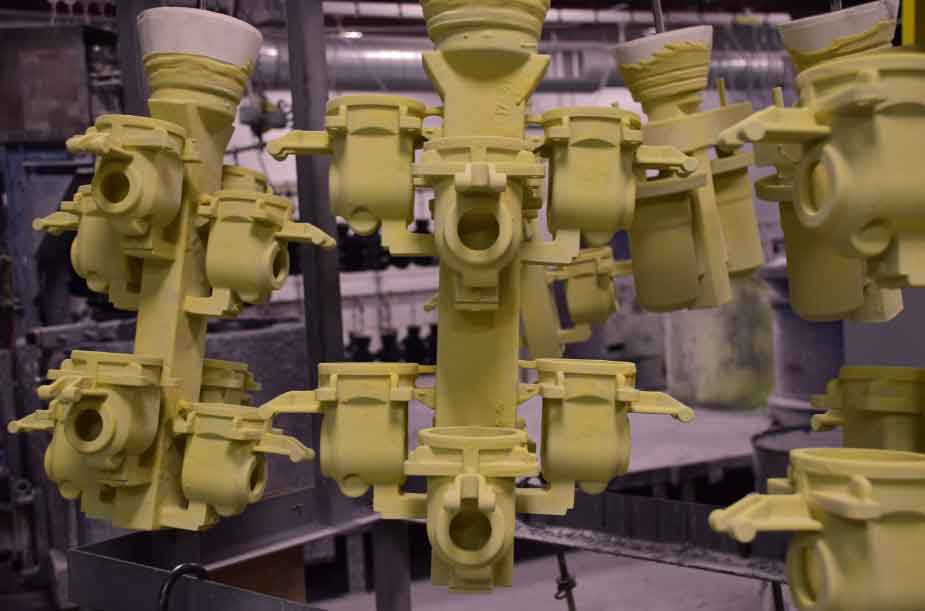
Investment casting, also known as precision casting or lost wax casting, is a versatile and precise metal manufacturing process that allows for the production of complex and high-quality metal components. It is widely used in various industries, including aerospace, automotive, defense, medical, and more. Here is a comprehensive guide to investment casting, covering its process, advantages, applications, and considerations:
1. Process Overview:
- Pattern Creation: The process begins with the creation of a pattern, typically made of wax or a wax-like material. The pattern is an exact replica of the desired final metal component.
- Pattern Assembly: The patterns are attached to a wax runner system to form a cluster, also known as a tree.
- Shell Molding: The tree is dipped into a ceramic slurry and coated with fine ceramic particles multiple times to create a ceramic shell around the patterns.
- Dewaxing: The ceramic shell is heated to remove the wax, leaving behind a cavity in the shape of the desired component.
- Metal Pouring: The ceramic shell is preheated, and molten metal is poured into the cavity, filling the space previously occupied by the wax pattern.
- Cooling and Solidification: The molten metal solidifies within the ceramic shell to form the final metal component.
- Shell Removal: The ceramic shell is removed, and the metal component is cleaned and finished through processes such as cutting, grinding, machining, and heat treatment.
- Inspection and Quality Control: The final component undergoes inspection to ensure it meets the required specifications and quality standards.
2. Advantages of Investment Casting:
- Complex Geometries: Investment casting allows for the production of intricate and complex geometries that would be difficult or impossible to achieve through other manufacturing processes.
- Excellent Surface Finish: The investment casting process yields components with smooth surface finishes, reducing the need for additional machining or finishing operations.
- Dimensional Accuracy: Investment casting provides high dimensional accuracy, as the metal component replicates the exact shape of the wax pattern.
- Wide Material Selection: Investment casting accommodates a wide range of materials, including stainless steel, carbon steel, aluminum alloys, titanium alloys, and more.
- Versatility: Investment casting is suitable for both small and large-scale production runs, making it a versatile manufacturing process.
- Cost-Effectiveness: While investment casting may have higher initial tooling costs, it can offer cost savings in complex designs by eliminating the need for multiple machining operations or assembly.
3. Applications of Investment Casting:
- Aerospace: Investment casting is widely used in aerospace applications, including turbine blades, engine components, structural parts, and more.
- Automotive: Investment casting is employed in the automotive industry for components such as engine parts, transmission components, suspension parts, and braking systems.
- Medical: Investment casting is utilized for producing medical implants, orthopedic devices, dental tools, and surgical instruments.
- Defense: Investment casting is applied in the defense industry for manufacturing components like firearms, military vehicle parts, and ammunition.
- Energy: Investment casting finds applications in the energy sector for producing turbine components, oil and gas industry parts, and renewable energy equipment.
- General Engineering: Investment casting is used in various general engineering applications, such as pumps, valves, gears, and fittings.
4. Considerations in Investment Casting:
- Design for Manufacturing: Design considerations should be made to ensure proper material flow, avoid casting defects, and facilitate easy removal of the ceramic shell during the dewaxing process.
- Surface Finish and Tolerance Requirements: Depending on the application, specific surface finish and tolerance requirements should be defined to achieve the desired level of precision.
- Material Selection: Proper material selection is crucial to meet the mechanical, chemical, and thermal properties required for the application.
- Tooling and Pattern Costs: Initial tooling and pattern costs should be considered, especially for smaller production runs. However, investment casting can offer cost savings in complex designs that require fewer machining operations.
Investment casting provides a highly accurate and versatile manufacturing process for the production of intricate and high-quality metal components. By understanding the process, advantages, applications, and considerations, manufacturers can effectively leverage investment casting for their specific needs in a wide range of industries.
